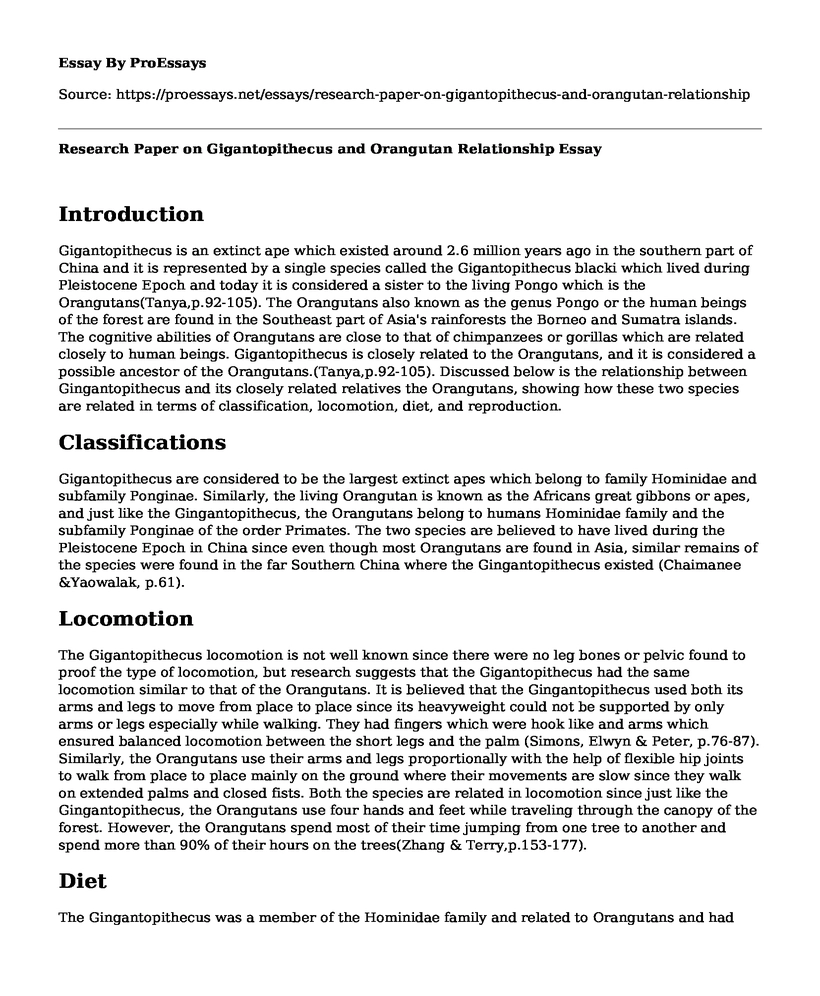Introduction
Gigantopithecus is an extinct ape which existed around 2.6 million years ago in the southern part of China and it is represented by a single species called the Gigantopithecus blacki which lived during Pleistocene Epoch and today it is considered a sister to the living Pongo which is the Orangutans(Tanya,p.92-105). The Orangutans also known as the genus Pongo or the human beings of the forest are found in the Southeast part of Asia's rainforests the Borneo and Sumatra islands. The cognitive abilities of Orangutans are close to that of chimpanzees or gorillas which are related closely to human beings. Gigantopithecus is closely related to the Orangutans, and it is considered a possible ancestor of the Orangutans.(Tanya,p.92-105). Discussed below is the relationship between Gingantopithecus and its closely related relatives the Orangutans, showing how these two species are related in terms of classification, locomotion, diet, and reproduction.
Classifications
Gigantopithecus are considered to be the largest extinct apes which belong to family Hominidae and subfamily Ponginae. Similarly, the living Orangutan is known as the Africans great gibbons or apes, and just like the Gingantopithecus, the Orangutans belong to humans Hominidae family and the subfamily Ponginae of the order Primates. The two species are believed to have lived during the Pleistocene Epoch in China since even though most Orangutans are found in Asia, similar remains of the species were found in the far Southern China where the Gingantopithecus existed (Chaimanee &Yaowalak, p.61).
Locomotion
The Gigantopithecus locomotion is not well known since there were no leg bones or pelvic found to proof the type of locomotion, but research suggests that the Gigantopithecus had the same locomotion similar to that of the Orangutans. It is believed that the Gingantopithecus used both its arms and legs to move from place to place since its heavyweight could not be supported by only arms or legs especially while walking. They had fingers which were hook like and arms which ensured balanced locomotion between the short legs and the palm (Simons, Elwyn & Peter, p.76-87). Similarly, the Orangutans use their arms and legs proportionally with the help of flexible hip joints to walk from place to place mainly on the ground where their movements are slow since they walk on extended palms and closed fists. Both the species are related in locomotion since just like the Gingantopithecus, the Orangutans use four hands and feet while traveling through the canopy of the forest. However, the Orangutans spend most of their time jumping from one tree to another and spend more than 90% of their hours on the trees(Zhang & Terry,p.153-177).
Diet
The Gingantopithecus was a member of the Hominidae family and related to Orangutans and had diverse dental specialization adapted to foraging in places where tree products were insufficient but the grassland was plenty. These Characteristics of the Gingantopithecus clearly shows that it is closely related to the Orangutans in terms of the diet since similarly to Gingantopithecus, the Orangutans do eat vegetarian foods and the only difference between the two is that the Orangutans can sometimes consume invertebrates and in rare occasions eat meat( Daegling, David & Frederick, p.527-532).
Reproduction
Been in a family of Hominidae and Pongean subfamily and order of primates, it is obvious that these two species reproduce sexually. Evidence suggests that just like the Orangutans, Gingantopithecus had two phases of sexual maturation adult males and the sub adult males. Adults' males' posses secondary sexual characteristics and are larger with high testosterone levels due to big sized heads enhanced by cheek pads. The adult males have long call roars which can be heard from about 1.2 kilometers away and are used to attract the females who do not have the sequential roars. Sexually receptive adult females attract more adult and sub-adult males (Mina, 2017).
Conclusion
In conclusion, it is evident that the Gingantopithecus are closely related to their closest relatives the Orangutans in several ways. The two species both belong to the same order of Primates, class Hominidae and the Ponginae subclass. Their similarities in knuckle movements, reproduction, vegetarian diet, and classification show that the Gingantopithecus are ancestors of the Orangutan hence the close relationship between the two.
Works Cited
Adnan, Mina. "Meta-analysis of the origin of bimaturism in orangutan males." (2017). https://scholarscompass.vcu.edu/cgi/viewcontent.cgi?referer=https://scholar.google.com/&httpsredir=1&article=1257&context=uresposters.Accesed 12th February 2019.
Daegling, David J., and Frederick E. Grine. "Bamboo feeding, dental microwear, and diet of the Pleistocene ape Gigantopithecus blacki." South African Journal of Science90.10 (1994): 527-532. https://www.researchgate.net/profile/Frederick_Grine/publication/236410375_Bamboo_feeding_dental_microwear_and_diet_of_the_Pleistocene_ape_Gigantopithecus_blacki/links/02e7e533020026d070000000/Bamboo-feeding-dental-microwear-and-diet-of-the-Pleistocene-ape-Gigantopithecus-blacki.pdf.Accessed 12th February 2019.
Chaimanee, Yaowalak. "A Middle Miocene hominoid from Thailand and orangutan origins." Nature 422.6927 (2003): 61. https://www.nature.com/articles/nature01449.Accessed 12th February 2019.
Simons, Elwyn L., and Peter C. Ettel. "Gigantopithecus." Scientific American 222.1 (1970): 76-87. https://www.jstor.org/stable/24964456?seq=1#page_scan_tab_contents.Accessed 12th February 2019.
Smith, Tanya M. "Dental development in living and fossil orangutans." Journal of human evolution 94 (2016): 92-105. https://www.sciencedirect.com/science/article/pii/S0047248416000324.Accessed 12the February 2019.
Zhang, Yingqi, and Terry Harrison. "Gigantopithecus blacki: a giant ape from the Pleistocene of Asia revisited." American journal of physical anthropology 162 (2017): 153-177.https://onlinelibrary.wiley.com/doi/full/10.1002/ajpa.23150.Accessed 12th February 2019.
Cite this page
Research Paper on Gigantopithecus and Orangutan Relationship. (2022, Nov 09). Retrieved from https://proessays.net/essays/research-paper-on-gigantopithecus-and-orangutan-relationship
If you are the original author of this essay and no longer wish to have it published on the ProEssays website, please click below to request its removal:
- The Mystery of Black Holes Essay
- Essay Sample on Hubble's Contributions to Astronomy
- Water as a Reactant Paper Example
- Unearthing the Untold: Paper Example on Archaeology in the Philippines
- Essay Sample on Exploring Prehistoric Life at Jericho: Studying Ancient Communities Through Archaeology
- Paper Example on Employee Exposure to Methyl n-Amyl Ketone: An Evaluation
- Paper Sample on Social Distancing: An Effective Measure to Fight Coronavirus (COVID-19)







